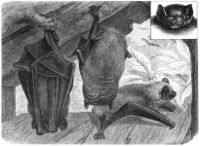Bat & Butterfly Houses
Evening bats or, perhaps more correctly, Vesper bats (family Vespertilionidae) are the largest and best-known family of bats. They belong to the suborder Microchiroptera (microbats). more...
There are over 300 species distributed all over the world, on every continent except Antarctica. Sometimes the family is called "common bats".
Characteristics
Almost all Vesper bats are insect-eaters, exceptions being some Myotis and Pizonyx that catch fish and the larger Nyctalus species that have been known on occasion to catch small Passerine birds in flight. The dental formula of vesper bats varies between species:
They rely mainly on echolocation, but they lack the enlarged noses that some microbats have in order to improve the ultrasound beam, and instead "shout" through their open mouths to project their ultrasound beam. In compensation many species have relatively large ears.
As a group, Vesper bats cover the full gamut of flight ability with the relatively weak flying Pipistrellus that have fluttery, almost insect-like flight to the long winged and fast flying genera such as Lasiurus, Nyctalus and Miniopteris. The family size range is from 3 to 13 cm in length, excluding the tail, which is itself quite long in most species. They are generally brown or grey in color, but some have brightly colored fur, with reds, oranges, and yellows all being known, and many having white patches or stripes.
Most species roost in caves, although some make use of hollow trees, rocky crevices, animal burrows, or other forms of shelter. There is also a great variation in the size of vesper bat colonies, with some roosting alone, and others in groups of anything up to a million individuals. Species native to temperate latitudes typically hibernate, while a few of the tropical species aestivate.
Read more at Wikipedia.org



